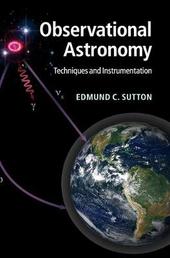
|
Observational Astronomy: Techniques and Instrumentation
Hardback
Main Details
| Title |
Observational Astronomy: Techniques and Instrumentation
|
| Authors and Contributors |
By (author) Edmund C. Sutton
|
| Physical Properties |
| Format:Hardback | | Pages:428 | | Dimensions(mm): Height 255,Width 180 |
|
| Category/Genre | Observatories, equipment and methods |
|---|
| ISBN/Barcode |
9781107010468
|
| Classifications | Dewey:520 |
|---|
| Audience | | Professional & Vocational | | Tertiary Education (US: College) | |
|---|
| Illustrations |
Worked examples or Exercises; 18 Tables, black and white; 16 Plates, color; 250 Line drawings, unspecified
|
|
Publishing Details |
| Publisher |
Cambridge University Press
|
| Imprint |
Cambridge University Press
|
| Publication Date |
13 October 2011 |
| Publication Country |
United Kingdom
|
Description
Astronomy is fundamentally an observational science and as such it is important for astronomers and astrophysicists to understand how their data are collected and analyzed. This book is a comprehensive review of current observational techniques and instruments. Featuring instruments such as Spitzer, Herschel, Fermi, ALMA, Super-Kamiokande, SNO, IceCube, the Auger Observatory, LIGO and LISA, the book discusses the capabilities and limitations of different types of instruments. It explores the sources and types of noise and provides statistical tools necessary for interpreting observational data. Due to the increasingly important role of statistical analysis, the techniques of Bayesian analysis are discussed, along with sampling techniques and model comparison. With topics ranging from fundamental subjects such as optics, photometry and spectroscopy, to neutrinos, cosmic rays and gravitational waves, this book is essential for graduate students in astronomy and physics. Electronic and colour versions of selected figures are available online at www. cambridge.org/9781107010468.
Author Biography
Edmund C. Sutton is Associate Professor in the Astronomy Department at the University of Illinois. His research has been primarily in infrared and sub-millimeter astronomy with an emphasis on instrumentation.
|